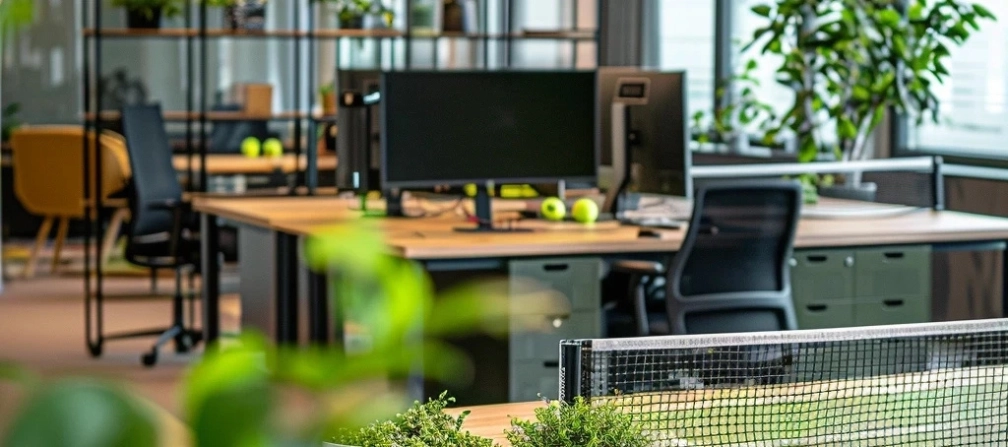WorkTime is a staff monitoring software that helps raise the efficiency of office and distant workers thanks to its impressive experience of over 20 years.
1. Why does a healthy work environment matter?
If you’ve ever wondered what an unbalanced office life can do to us, this doll is a great example. Scientists from the UK, France, and Germany say in their report that a creepy Emma the doll is what an average office employee could look like in 20 years if changes aren't made to the workplace environment.
Photos by Fellowes
The need for a healthy work environment becomes more obvious each new year. According to the World Health Organization (WHO), a healthy work environment should be achieved for three reasons: 1. It's the right thing to do. From a business ethics perspective, the comfort of employees in their positions is crucial. Human rights currently form the foundation of our society. Any field that involves people should respect these rights. 2. It's a sensible decision. Any entrepreneur knows that the happiness of their employees impacts their productivity. Therefore, comfort at work is important. 3. It's legal. This point is directly related to the first, as human rights are not only a moral and ethical concept but have become fundamental laws. Respecting workers' rights and developing a good healthy work environment are steps towards legality. So, the question is, what can employers and employees do to maintain well-being at their workplaces, and how to create a healthy work environment? Is there a chance for a better fate for the future office worker? We will base the answer on various studies and our own best practices.2. How to maintain a healthy atmosphere at a workplace
Although it may appear horrific at first glance, the ugly office doll Emma serves as a warning to individuals who have to obey a 9-to-5 working schedule. Is it the real face of the future employee? In the United Kingdom alone, Emma the doll represents employees who have strained eyes (50%) and backs (48%) or headaches (48%) due to their job. The doll is overweight, has bloated limbs, and has stress-related dermatitis. That is because of the absence of a healthy work environment.Overall, multiple studies have shown over and over that mental and physical illness can make people less likely to show up at work and be productive. This is the main reason why companies need to push for overall health initiatives and follow specific recommendations from experts to achieve a healthy work environment. So, what is a healthy work environment, and how to support it? Is there a way to change the future office worker for the better?Meet Emma, the grim future of office workers. With WorkTime monitoring software, you can avoid the consequences of unhealthy working habits and improve the moods of your staff.
3. Keep an eye on office nutrition
Healthy meals
This is one of the primary signs of a healthy work environment. The snacks placed on coworkers' desks can contribute a few hundred extra calories to the daily diet of their colleagues. Regularly indulging in these snacks can result in unwanted weight gain over time. Three out of five Americans are overweight, implying that there's probably more than one person in an office who is on a diet. In most workplaces, individuals strive to shed pounds, so consider teaming up with colleagues to replace candy bowls with fruit bowls, for instance. Also, encourage others to swap their candy bowls for healthier alternatives.Enough water
This tip is essential for creating a healthy work environment. One way to ensure that you stay well-hydrated is to drink eight to ten glasses of water daily. Fruits such as oranges, grapefruit, grapes, watermelon, and apples are great ways to stay hydrated and healthy, and many foods also include water. A good way to remind oneself it is time to refill is by setting an alarm on their computer to go off. Remember: Consuming a nutritious lunch is an essential component of a well-balanced diet and a healthy work environment. Motivate colleagues not to skip lunch (make sure they eat three times per day altogether). After all, it is possible to estimate the time for lunch using login & logout tracking software. Some companies may require staff to logout when they go for a meal.Eating in proper proportions is an essential component of overall health. It is also recommended to detect vitamins you lack and consume more goods with them.
4. Organize workstation and workflow
To understand how to organize office workflow, the best idea would be to evaluate your space and its size. Does it actually correspond to your team’s size? Organizing workflow consists of several vital stages.Come up with various zones
To come up with a better workflow organization, divide your office into different zones based on the tasks you perform. For example, create a separate area for computer work, designate a document space, and establish a section for storage. This will help you and your employees stay organized and focused on specific tasks without feeling overwhelmed by a desert of objects.Digital order matters
In addition to physical clutter, digital disorder can also hinder your focus. Here is what you and your workers may do. Organize your computer files by sorting and deleting any unnecessary documents or folders. Arrange your files into clearly labeled folders and establish a filing system that makes sense.Involve special apps
Utilize productivity tools such as note-taking apps or time monitoring software to track tasks and deadlines. This will help you maintain a clear and efficient digital workspace and a healthy work environment.You can keep track of activity time and even software used by your staff using WorkTime. The software lets you personalize reports according to your needs so you can see how each employee is doing or how productive your entire department is.
Think about storage
Finally, invest in storage solutions. Use solutions that meet your needs and maximize your space. Consider using cabinets, shelves, or wall organizers to keep everything in place. Utilize labels or color-coded folders to find important documents or supplies easily. Having a designated place for everything will save you time searching for items, allowing you to focus on your work. Do not forget about digital storage solutions, such as cloud. Perhaps, the future office worker will have access to even more advanced technologies.5. Dedicate time to physical exercises
Even if there is no opportunity to go outside the other day or leave a sit for some time, concentrate on neck issues. Tension neck syndrome (TNS) can occur when the neck and upper shoulders are held in a fixed, awkward position for long periods of time.Have regular walks
Regular exercising is one of the best ways to maintain a healthy work environment and physical fitness level. It's a fantastic idea to go for a walk while eating lunch. Not only are you burning calories, but you're de-stressing and refreshing then. Interestingly, you can burn 100-200 calories with 30 minutes of brisk walking.Avoid easy ways
We suggest finding a walking companion you can rely on to go for a walk every day - someone who will force you to go even when being busy. Taking the stairs instead of the elevator should become second nature. Another similar idea is parking further away than usual to ensure a little walk to work each morning, and evening might suffice if you truly cannot leave the house at lunch.Regular exercise has been shown to decrease the risk of chronic diseases such as stroke, heart disease, and diabetes.
6. Provide employees with more control
Scheduling stability for staff
Several studies have found that giving workers more choice or control over their work schedules improves their mental health. Enhanced scheduling stability for employees resulted in a 5% increase in labor productivity and a 7% increase in the median sales of the participating stores. Additionally, the increased stability reduced tension and enhanced sleep quality for employees with children.Regular daily breaks
Although it may seem counterintuitive, regular daily breaks are crucial for maintaining a healthy work-life balance. It's easy to get caught up in work and forget to take time for yourself. However, short breaks can actually enhance productivity and prevent burnout. Staff can use these breaks to take a walk, communicate, stretch, or engage in activities that help relax and recharge. By incorporating breaks into the work schedule, you can better establish boundaries and avoid overload. Let employees choose the time for their breaks as each has their own more and less productive hours.No bad habits
It is hard to imagine the process of creating healthy work environments when workers smoke or consume alcoholic beverages in the office. At the same time, employees should be encouraged to minimize bad habits (or get rid of them at all). It is better for coworkers to quit smoking or reduce smoking breaks, as well as minimize alcohol consumption.Being honest with families
Encourage staff to have open and honest conversations with their loved ones about work boundaries, especially when they plan to work from home. Discuss their work hours and let them know when you need uninterrupted time. Employees have to encourage their families to respect their workspace and avoid unnecessary interruptions during designated work hours so as not to get nervous. That is how you and your employees can create a supportive healthy work environment that allows both sides to focus and be productive.Employers can still check their productivity with WorkTime even when staff ask to work remotely. This solution helps improve the quality of monitoring employee work processes while alleviating the pressure on managers. If a worker can prove they work actively from home, why won't let them do so further if they feel more comfortable?
7. Take care of the healthy work environment
Go green
Probably, you've already noticed that some creative office environments may remind one of the jungle. One of the key benefits of having plants in your office is their ability to improve indoor air quality. Plants naturally absorb carbon dioxide and release oxygen, which can help reduce the levels of pollutants and toxins in the air. This can lead to a clean and healthy work environment, ultimately contributing to stress reduction and overall well-being. Incorporating plants and greenery into the office environments can significantly impact productivity and overall well-being. Numerous studies have shown that having plants in a workspace can enhance creativity, cognitive function, and concentration.Employees with plants in their offices reported a 15% increase in productivity compared to those working in plant-free environments.
8. Avoid long stretches of long days
In other words, it's necessary to avoid burnout. Occasionally, people focus on the task at hand and getting a project done, and they aren't aware of its impact on their health. They may not be aware of it until the stress is at a really high level, and it's affecting their relationships and moods. Burnout can also weaken a person's nervous system, making it hard to sleep and focus. Thus, active and idle time monitoring software can help overcome associated stress.Use WorkTime to track active working time and prevent staff from getting overloaded and stressed. Make a difference between active and idle time - see whether any of your employees overwork to prevent them from facing stress.
9. Agree on the common schedule
Erratic, unpredictable schedules make it hard for frontline workers to manage their personal lives and family responsibilities. A greater schedule stability can benefit both companies and employees, contributing to a healthy work environment.Dreaming of flexibility
Today, employees desire more than the traditional 5-day workweek or 8-hour workday. Currently, employees are most interested in benefits that offer them greater flexibility, including remote work, a 4-day workweek, and/or a flexible schedule where they can come in any time, provided they complete the required number of hours.- This expert research determined that flexible schedules and work-from-home opportunities influence decisions regarding job acceptance or resignation.
- More than half of the employees state that they would prefer transitioning to a job with a flexible schedule.
- 37% of workers would like to move to another company where they could work outside the office environments at least part of the time.
Define availability
Maintaining a consistent work schedule is crucial for setting boundaries and achieving a healthy work-life balance. Just because you work from home doesn't mean you have to be available 24/7. Define your regular working hours and stick to them as much as possible. Communicate your availability to colleagues and clients, indicating when you are/are not available for meetings or tasks. By establishing a routine, you can better separate work time from personal time.WorkTime can help define the most productive hours to decide on the active time for everyone. This tool will help you reach a compromise with employees regarding the best and most comfortable schedule.
10. Guarantee safe commuting
Make employees feel safe: build or ensure there are shelters in case of any force majeure, ensure the building is not too old, etc. Also, be aware of the surroundings - if any areas around or the office itself contain certain threats that have to be prevented. It is important that employees report any unsafe conditions or rule breaks while employers ensure the company sticks to the highest security and safety standards.How about digital safety?
Sure, it's impossible to ignore virtual security. Some employees may get stressed if they find out their actions are recorded via camera or their entire browsing history is being watched. Thus, it’s necessary to use non-invasive employee monitoring software.WorkTime enhances productivity while maintaining respect for privacy. Our company delivers a non-intrusive monitoring system that provides precise numbers regarding employee productivity without capturing any sensitive information about the employees. No screenshots or keystrokes - only ethical methods!
11. Involve mental practices
It is important to take mindful breaks throughout the workday regularly. These breaks can be as short as a few minutes and may involve activities such as deep breathing exercises, yoga, stretching, or simply taking a few moments to observe the surroundings. Intentionally, stepping away from work and engaging in mindful activities can help reduce stress levels and improve overall well-being. In the modern, rapidly changing world, stress has become a common companion for many people, especially those working from home. Personal commitments, juggling work responsibilities, and household tasks can impact mental well-being. However, practicing mindfulness can help alleviate stress and improve overall mental health.Involve positive thinking
Practicing gratitude and positive thinking can significantly contribute to stress reduction and improve mental health. Take a few minutes each day to reflect on things you are thankful for, whether it's a completed task, supportive colleagues, salary compensation, or a comfortable workspace. By focusing on the positive aspects of your healthy work environment, you can shift your mindset and enhance overall productivity. For the office workers of the future, thinking positively is crucial. One effective strategy for reducing stress and enhancing productivity is incorporating mindful meditation into your daily life. Find a quiet space in your office, sit comfortably, and focus on your breath. As you inhale and exhale, release any racing thoughts or distractions.This simple practice can help calm your mind, increase self-awareness, and improve your ability to concentrate on the tasks at hand. Practice it in a group with your employees.
12. Make sure employees receive enough training
The future of office workers depends heavily on the quality of their training. Giving employees more training so they can take on new tasks and resolve more customer complaints on their own can improve both the employees' well-being and their performance on the job. Also, show how employees perform and even include rewards for accomplishing training and various tasks to engage them more.Compare your employees’ performance using WorkTime before and after training and psychological sessions. Find out how effective those incentives are and whether it is better to change them - don’t waste your costs on useless solutions!
13. Hire more staff if necessary
Try to divide workload fairly among all employees and hire extra units if critical. Also, encourage managers to support workers in need. This will assist with creating a friendly team atmosphere at the workplace.Expanding the team
Long hours or pressure to work hard or fast can harm employee health and well-being, according to research. Numerous studies show that excessive demands and low control increase blood pressure and lead to cardiovascular disease and depression. Adding staff to meet demand may appear expensive, but employers lose when fatigued or irritated workers burn out, are absent, or resign. Strategic personnel changes may increase efficiency and job satisfaction.Help from managers
Office workers of the future would be definitely better off with some professional assistance. A nursing home study indicated that staff whose managers accommodated their family requirements had fewer cardiovascular disease risk factors and slept better. Manager training initiatives to promote family-supportive behaviors have shown promise for work-life balance and health in healthcare and grocery stores. When supervisors received this training, employees were happier, performed better, and were less likely to quit.Use WorkTime to find out whether any of your employees fall behind their tasks. Then, you’ll realize who needs help or manager’s supervision.









